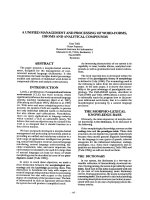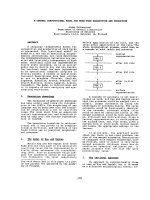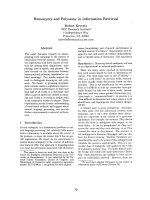Semantics Topic Word Meaning Homonymy And Polysemy; Synomyms And Antonyms Bài Tiểu Luận Nhóm Mình Thực Hiện Cho Môn Ngữ Nghĩa Học_.Pdf
Bạn đang xem bản rút gọn của tài liệu. Xem và tải ngay bản đầy đủ của tài liệu tại đây (1.36 MB, 22 trang )
<span class="text_page_counter">Trang 1</span><div class="page_container" data-page="1">
<b> 0 </b>
<b>MINISTRY OF EDUCATION AND TRAININGTHUONG MAI UNIVERSITY</b>
</div><span class="text_page_counter">Trang 2</span><div class="page_container" data-page="2"><b>B. THEORY OF WORD MEANING...6</b>
<b>I. WORDS AS MEANINGFUL UNITS...6</b>
<b>II. FORMS AND EXPRESSION...6</b>
<b>2. Ambiguity and the role of contexts...11</b>
<b>3. Difference Between Polysemy and Homonymy...12</b>
</div><span class="text_page_counter">Trang 3</span><div class="page_container" data-page="3"><b>List of members of Group 6:Ordinal </b>
<b>Task Assignment:</b>
Synonymy Nguyễn Thùy Linh Introduction + Words as meaningful units
and Forms and expression
Nguyễn Thị Thùy Linh
Homonymy Tráng Thùy Linh Polysemy + Sum Word, Powerpoint text
file up
Trần Phương Linh (Leader)
Antonymy + Closing + Control a game Lê Thị Ngọc Mai
3
</div><span class="text_page_counter">Trang 4</span><div class="page_container" data-page="4"><b> A. INTRODUCTION</b>
Semantics introduces the basic concepts and methods of analyzing the meaning of natural languages with a wide range of topics on the meaning of language.
The course helps students work with real data languages. Exercises are based on semantic concepts and philosophical and practical problems, encouraging students to build a solid knowledge of semantics, clarify problems by analyzing and synthesize different semantic features in English. The content covers topics in semantic theory, semantic categories, context and inference, topic roles (words), and speech acts.
As learners, we discussed the topic “Word meaning: Homonymy and polysemy; synomyms and antonyms”. Learning a word's meaning is just one part of understanding that word. Once we know a word's antonyms, synonyms, and homonyms, we can add lots of variety to speech and writing. But what are synonyms and antonyms, and what do they have to do with homonymy, polysemy? Learn more about each type of word and how they can help increase your vocabulary.
4
</div><span class="text_page_counter">Trang 5</span><div class="page_container" data-page="5"><b>B. THEORY OF WORD MEANINGI. WORDS AS MEANINGFUL UNITS</b>
- Words are regarded as the smallest indivisible meaningful units of a language which can operate independently
- i.e: book, bookish: word -ish: not word real, unreal: word un- : not word
<b>II. FORMS AND EXPRESSION</b>
- There are 9 forms but only 8 word-expressions - Words are also considered expressions
- Words and words forms are distinguished from each other in terms of the distinction between lexical and grammatical meanings
i.e: There is no way of telling what it is. I do not like what you do everyday. I have a book.
- Forms of one and the same word have the same lexical meaning whereas different words have different lexical meanings
<b>III. HOMONYMY</b>
<b>1. Definition</b>
Modern English is exceptionally rich in homonymous words and word-forms. It is held that languages where short words abound have more homonyms than those where longer words are prevalent. The definition of homonymy is rather broad, therefore, what is the meaning of homonyms? Homonyms are words which are identical in sound and spelling, or at least, in one of these aspects, but different in their meaning.
5
</div><span class="text_page_counter">Trang 6</span><div class="page_container" data-page="6">I hope you are not lying to me. My books are lying on the table.
Absolute homonyms are words that have the same spelling and pronunciation, but different meanings.
Absolute homonyms should satisfy 3 conditions: + They will not be related in meaning.
+ All their forms will be identical.
+ Similar forms are grammatically equivalent each other in terms of Example:
“Found” /fɑʊnd/ (past tense of the verb: “find” /faɪnd/; tìm thấy, nhận ra) and “Found” /fɑʊnd/ (verb: thành lập)
- I just found a suitable organization for me to do volunteer work, and I also want to found my own charity fund one day.
2.2. Partial homonyms
Full homonyms: words that have the same spelling, same pronunciation but different word forms and different meanings.
Example: “Bear” /beər/ (verb: chấp nhận, chịu đựng) and “Bear” /beər/ (noun: con gấu)
Homophones: same pronunciation
6
</div><span class="text_page_counter">Trang 7</span><div class="page_container" data-page="7">Homophone" ("homo-" means "giống" and "-phone" means "âm"): words with different meanings but with the same pronunciation, may or may not have the same spelling.
Example: “flour” /ˈflaʊə(r)/ (noun: bột) and “flower” /ˈflaʊə(r)/ (danh từ: hoa). My mom buys some flour to make cakes for me.
Her husband gave her flowers on their wedding anniversary. Homographs: same spelling
Homograph" ("homo-" means "giống" and "-graph" means "viết"): words with different meanings but with the same spelling, which may or may not have the same pronunciation.
Example: “Present” /ˈpreznt/ (noun: món q) and “present” pri’zent/ (verb: trình bày, giới thiệu)
I gave her a present on her graduation ceremony.
My teammates must present the research to the class in 15 minutes.
<b>3. Sources of homonyms </b>
Phonetic change (Convergent sound development)
+ Two or more words pronounced differently on an earlier date can develop identical sound patterns.
For example:
new - knew (k - was pronounced in old English)
The verb “to write” in O.E. had the form “to writan” and the adjective “right” had the form “reht” or “riht.”
Borrowing
7
</div><span class="text_page_counter">Trang 8</span><div class="page_container" data-page="8">+ A borrowed word may duplicate in form either a native word or another borrowing.
For example: Leg (n) - leggr (Borrow Old Norse) Disintegration or split of polysemy.
+ Different meanings of the same word move so far away from each other that they come to be regarded as two separate units.
Example: spring
– the act of springing, leap
– a place, where a stream of water comes up out to the sky – a season of the year.
Historically all three originate from the same verb with meaning ‘to jump, to leap’. This is the Old English word “springun”.
Word-formation - Conversion
+ Homonyms of this type, which are the same in sound and spelling but refer to different categories of parts of speech, are called lexico-grammatical homonyms. Example:
“comb” (n) – “comb” (v) “pale” (adj). – “pale” (v)
- Shortening is a further type of word-building which increases the number of
</div><span class="text_page_counter">Trang 9</span><div class="page_container" data-page="9">Example:
Boom: a deep and loud hollow sound
Boom: to increase or become successful and produce a lot of money very quickly
<b>IV. POLYSEMY</b>
<b>1. Definition</b>
Polysemy refers to a word that has two or more meanings and the meanings are related to each other to some extent. The phenomenon of polysemous words is observed in most languages of the world.
→ man: người đàn ông
He is not the <b>man</b> who Mary is looking for. (Anh ấy không phải là người đàn ơng mà Mary đang tìm kiếm)
→ man: con người
The damage caused by <b>man</b> to the environment is serious. => That’s a case of polysemy.
<b>2. Ambiguity and the role of contexts</b>
Lexical context
The words or phrases that are used with the homonyms or poly-semantic word.
<b>E.g., Hot weather vs. hot news (Polysemy)</b>
Grammatical context
The grammatical structure in which a homonym or poly-semantic word is used. E.g., You <b>may</b> find this interesting. Vs. The event will be held in <b>May. (Homonymy)</b>
<b>=> Therefore, we see the role of context is extremely important. It helps to distinguish polysemy from homonymy.</b>
9
</div><span class="text_page_counter">Trang 10</span><div class="page_container" data-page="10">An example about ambiguity:
We found schools and hospitals.
Lexical ambiguity Grammartical ambiguity
+ To set up, to establish. + To discover, to come across
+ Present tense of found + Past tense of find
So, to eliminate ambiguity in this example, we can change it as followed: Grammatical equivalence
+ We have found schools and hospitals. + He/ she founds shools and hospitals.
Context
+ We found schools and hospitals which help people have a better life. + We found schools and hospitals on the way we headed for the city center.
<b>3. Difference Between Polysemy and Homonymy</b>
Polysemy Homonymy Definition The coexistence of many
possible meanings for a word or phrase.
The existence of two or more words having the same spelling or pronunciation but different meanings and origins.
10
</div><span class="text_page_counter">Trang 11</span><div class="page_container" data-page="11">Meanings Polysemy has different, yet
Dictionaries Polysemous words are listed under one entry in
Polysemous words can be understood if you know the meaning of one word.
The meaning of
homonymous words cannot be guessed since the words have unrelated meanings.
<b>V. SYNONYMY</b>
<b>1. Definition</b>
Synonyms are actually words of the same parts of speech which have similar meaning but not identical meaning.
They may share a similar denotation or connotation meaning. They can differ from each other in terms of denotation or connotation.
<i>=> (So, we can understand) A synonym is a word that has the same or nearly thesame meaning as another word. However, these definitions are not completelysemantically correct, since the two words are completely identical in meaning -that is, the two words can be interchangeable in all cases without changing themeaning - are almost non-existent in English (Cruse, 2004, Hatch & Brown, 1995)(some exceptions will be mentioned in section 2 – Classification of Synonyms).</i>
11
</div><span class="text_page_counter">Trang 12</span><div class="page_container" data-page="12"><i>Instead, most synonyms can only substitute for the original word in certaincircumstances (Murphy, 2010).</i>
In a synonymic group, there is usually a synonymic dominant which is the most neutral.
Currently, there are 8000 groups of synonyms.
<i><b>Example: Look – Stare – Gaze – Glance: Look</b></i>
<i>→ All four words above mean look but at different levels:Look: Look, this is the best word to describe this action</i>
<i>Stare: Stare, usually used in case of looking out of curiosity or judging someoneGaze: Staring, usually used in the case of looking at in surprise or admirationGlance: Quick glance, to give a quick short look</i>
<i>And in this group the word look will be the most used and neutral word.</i>
+) <b>Beautiful</b> - attractive - pretty - lovely - stunning +) <b>Funny</b> - humorous - comical - hilarious - hysterical
<b>2. Classification</b>
2.1. Absolute (total) synonyms
Absolute synonyms are words that can replace the original word in all cases without changing the meaning of the sentence (Matthews, 2014). In other words, absolute synonyms are words that have the same definition as the original word, and there is no difference in meaning between the two words. Absolute synonyms must satisfy the following three conditions:
All their meanings are identical. They are synonymous in all contexts. They are semantically equivalent.
This type of word is very rare in English and probably with other languages as well. However, a few examples of this synonymy phenomenon can be
</div><span class="text_page_counter">Trang 13</span><div class="page_container" data-page="13">Fatherland/ motherland 2.2. Semantic synonyms
Semantic synonyms are words differing in denotational meaning and they are similar in connotational meaning, so they are almost not interchangeable. These words make up many synonyms in English.
- Example:
<b>Cry </b>- weep - scream: They all refer to the state of human tears Cry - tears shed because of misfortune, fear or pain
Weep - can express crying for joy
Scream - to cry on a high note, especially because of strong emotions such as fear, excitement, or anger
<b>Good - looking - pretty - handsome - beautiful: They all refer to the pretty and</b>
cute, the good side of something or someone. But we can see these words don't show any element in terms of symbolic meaning, when we talk about these words, we won't show any emotional element when we say so they can be understood as different in their denotational meaning and similar in their connotational meaning.
<b>Look – Stare – Gaze – GlanceDiscuss - debate - argue.</b>
2.3. Stylistic synonyms
Stylistic synonyms are words differing in connotational meaning and they are similar in denotational meaning.
- Example:
<b>Police - bobby - cop</b>
In the group of synonyms above, the word ‘policeman’ has a neutral meaning. Use 'cop' with disrespect or contempt, while the word 'bobby' is often used in speech. When speaking it shows different attitudes and points of view, so they are the same in terms of denotational meaning.
<b>Father - dad - daddy</b>
13
</div><span class="text_page_counter">Trang 14</span><div class="page_container" data-page="14">2.4. Semantic - stylistic synonyms
Semantic - stylistic synonyms are words differing both in denotational and connotational meaning.
- Example:
To end - to finish - to complete
To end - is the end, the end of something even though there may be no results To finish - you have done a predetermined part of the job or one of the assigned tasks
To complete - means you have completed all the assigned tasks/responsibilities
<b> To dismiss – to fire – to sack</b>
In the group of synonyms above, 'to dismiss' is a neutral word, meaning 'to let go'. + 'to fire' means to force.
+ And 'to sack' is to remove someone from a job, not to do it often because of incompetence.
<b> House - shack - slum - pad</b>
2.5. Phraseological synonyms
Phraseological synonyms are words which are different in their collocation (combinability: ability to be combined with different words).
- Example:
Do – make (to do exercises but to make money)
Language – tongue (native language, but to know languages)
To lift – to raise (to raise or lift a finger but to raise prices, wages, questions) Meaning – sense (the word has 2 senses or 2 meaning but a man of sense) 2.6. Territorial synonyms
Territorial synonyms are words employed in different regions (the words are different in Britain, Canada, The US, and Australia).
- Example:
Sidewalk (common in the US) - pavement (common on the other side of the Atlantic)
14
</div><span class="text_page_counter">Trang 15</span><div class="page_container" data-page="15">2.7. Euphemism
Literally means “speak well” => this is a soft, indirect way of talking to achieve a less unpleasant or offensive effect.
- Example:
<b>Redundant - be out of job/ unemployment.</b>
In the group of synonyms above, the word 'redundant' does not refer directly to job loss as the word 'unemployed' or 'be out of job'. Therefore, using this word will avoid rudeness, lack of tact or impoliteness.
<b>The underprivileged – the poor</b>
<b>3. Sources of synonyms</b>
3.1. Borrowing
<i>G.S Nguyen Hoa, in the book 'An Introduction to Semantics', pointed out that theorigin of most synonyms in English is due to borrowing, mainly from Greek, Latinand French. They become synonyms of the original words, forming groups ofsynonyms, in which the root word is usually a neutral word. French words areoften used in literature, and Latin and Greek words are used in science and ritualtexts.</i>
Some examples about words borrowed:
<b>Native English wordsWords borrowed from FrenchWords borrowed from Latin</b>
to ask to question to interrogate
to gather to assemble to collect
15
</div><span class="text_page_counter">Trang 16</span><div class="page_container" data-page="16">3.2. The change of meaning - Example:
Hand - worker: “hand - means the part of the body at the end of the arm that is used for holding, moving, touching, and feeling things and then it changes the meaning to become synonymous with worker.
Rich - fertile (soil) 3.3. Word - building
3.3.1. Use/Creation of phrasal verbs - Example:
To take care - to look after. to investigate - to look into
The term antonym comes from antonymy, which is the technical grammar term for words of the same part of speech that have contradictory meanings, but you can 16
</div><span class="text_page_counter">Trang 17</span><div class="page_container" data-page="17">think of antonyms as opposites. For example, hot and cold are antonyms, as are good and bad.
Antonyms can be all types of words: verbs, nouns, adjectives, adverbs, and even prepositions. Usually, adjectives denoting quality, verbs denoting actions or states and abstract nouns have antonyms.
In fact, there are many words, especially those denoting concrete objects such as dog, cake, desk,... that have no antonyms.
<b>2. Characteristics</b>
Antonymy has three characteristics.
First, antonyms have to belong to the same semantic field, nearly identical in distribution.
Second, they do not differ either in style or emotional coloring. Just look at another three pairs, heat/cold, single/married, and beauty/ugly. Although either of them is opposite in meaning, they could not be regarded as antonyms in that they are not the same in grammatical units.
Third, in many pairs of antonyms, one is marked and the other unmarked. The
<i>unmarked member is the one used in questions of degree. We ask ‘How high is</i>
<i>it</i>?’(not ‘How <i>low</i> is it?’) or ‘How <i>tall</i> is she?’ We answer ‘Three hundred meters high’ or ‘one and a half meters tall’ but never ‘One and a half meters short’, except humorously. <i>High</i> and <i>tall</i> are the unmarked members of <i>high/low</i> and <i>tall/short</i>.
<b>3. Classification</b>
According to conventional classification, there are two types of antonyms: The first one is the group of words of different forms and of opposite meanings, called root word antonyms or antonyms proper. The other is the class of words of the same root, one of which have a negative affix, called derivational antonyms.
In addition to the above classification, there is John Lyon’s classification that includes four main types: First, gradable antonymy is the commonest type of antonymy. Antonyms proper are easily gradable, based on the operation of gradation. They are opposite ends of a continuous scale of values. Second, complementary antonyms involve two items: the assertion of one is the negation of 17
</div>








